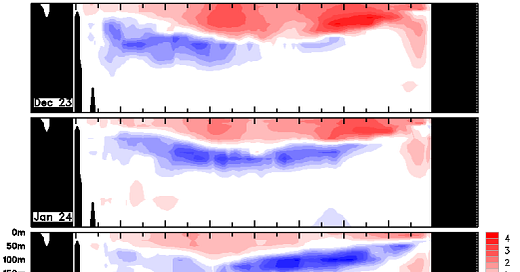March Records Fall Down Under; Hail Destroys 1,000s Of Acres Of Solar Panels In Texas; Sea Ice Above Multidecadal Norms; + Cool Waters: Signs La Niña Is Building
There is now a large pool of cooler-than-average water beneath the surface of the tropical Pacific Ocean.
March Records Fall Down Under
The past few days have seen monthly low temperature records fall across Australia.
In no particular order...
The high of 19.3C (66.7F) at Oakey, Queensland made for the town's coldest March day in books dating back to 1973, breaking the old 1980 record by 0.4C.
At 21.1C (70F), Brisbane Airport tied its lowest March max set in 1988, dating to 1951.
Staying in Queensland, the recent 16.9C (62.4F) at Applethorpe is just 1.4C shy of the state record for March.
Watarrka, NT registered a max of 15.8C (60.41F) which is 0.3C below its old monthly benchmark and also the 12th coldest March day in the Northern Territory.
Wulungurru's 17.7C (63.9F) bests the old 2021 Tmax by a 1.5C (also, the 13.7C (56.7F) Tmin there smashed the 2007 record by a 2.3C).
Point Lookout's 22.9C (73.2F) busted the old record by 0.3C; St George, at 19.7C (67.5F), also suffered its coldest March day, again by 0.3C; and in Rabbit Flat, the 22.4C (72.3F) there made for the second-coolest March day on record (only 2021 is lower).
Territory Grape Farm has gone and endured a daily high a full 1.3C below the previous 2021 record; while Arltunga's 16.3C (61.3F) went a decimal better, coming out 1.4C below the record low set, again, during the historically cold March of 2021.
Australia's early-season cold has proven fierce and widespread:


The continent is cooling, as per the satellite data (UAH).
Hail Destroys 1,000s Of Acres Of Solar Panels In Texas
A rather standard hail storm has just managed to dent the energy security of the state of Texas, such is the increasingly reckless dependence on an immature and unreliable technology: solar power.
"In yet another massive L for 'green' energy boondoggles, a massive swathe of solar panels in Damon, Texas were taken out by a hail storm," writes Will Tanner on X.
"Who will pay for the burial of all these panels and where will they bury them?" asks one concerned citizen online.
"That is what a massive money laundering scam looks like," writes another.
"These facilities are also within 5 miles of the Gulf Coast in some cases. Seems like fodder for hurricanes to me. More green energy nonsense. The federal money would be far better spent on new nuclear plants IMO."
Moreover, not only were the expensive panels rendered useless by a spot of weather, but now they're leaking a toxic compound, cadmium telluride, into the water.
Not only do Texans suffer intermittent energy, not only have they sullied tens-of-thousands of acres of land with ‘solar farms’, but now the pointless panels are leaching harmful substances into the groundwater.
"Nuclear energy and natural gas are the answer," continues Tanner. "They're cheap, clean, reliable, and won't be shattered by a bit of hail."
I, personally, believe solar does have its place, for small off-grid applications (such as my bolthole in Portugal), but the technology isn’t ready for large scale applications.
And just a word on the alarmist logic here:
So the plan is to build an energy infrastructure that is susceptible to extreme weather events during times of increasing extreme weather events?
Do I have that right?
Sea Ice Above Multidecadal Norms
Arctic sea ice extent in 2024 continues to track above the 21st century average.
Keep reading with a 7-day free trial
Subscribe to Electroverse Substack to keep reading this post and get 7 days of free access to the full post archives.




